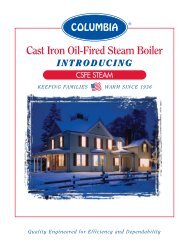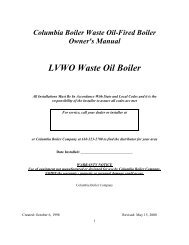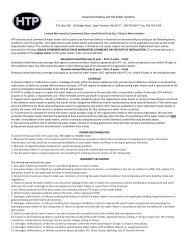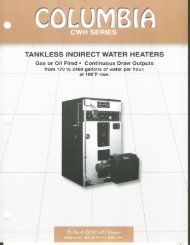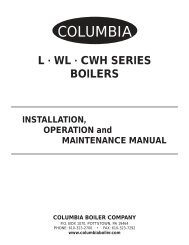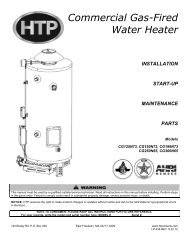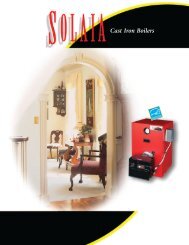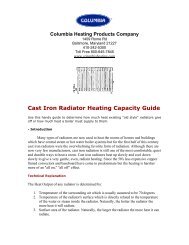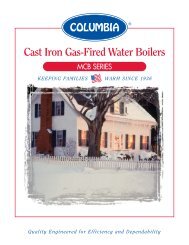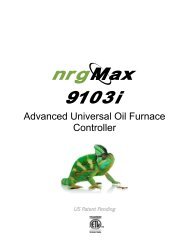MPH Manual - Columbia Heating
MPH Manual - Columbia Heating
MPH Manual - Columbia Heating
You also want an ePaper? Increase the reach of your titles
YUMPU automatically turns print PDFs into web optimized ePapers that Google loves.
Below a pH of 5.0 the water is acidic enough to dissolve the steel boiler plates. Under these<br />
conditions the steel gradually becomes thinner and thinner until its destruction. At a pH between<br />
5 and 9.4 pitting of shell plates will occur at a rate depending on the amount of dissolved oxygen<br />
in the boiler.<br />
Dissolved Oxygen<br />
Dissolved oxygen is caused by the solubility of atmospheric oxygen into the supply water. Aeration<br />
of the city water supply is frequently used to remove other noxious gasses. Efficient aeration<br />
results in saturation of the water with oxygen.<br />
The majority of corrosion problems are directly related to the quantity of dissolved oxygen in the<br />
boiler water. Elimination of the corrosive effect of dissolved oxygen can be accomplished both<br />
directly or chemically.<br />
Direct or mechanical removal of dissolved oxygen is accomplished through the use of a deaerator<br />
or by heating the water to a temperature above 180°F. <strong>Heating</strong> the water can be done with<br />
a preheater or a sparge tube installed in the return system.<br />
Chemical deaeration is done through the introduction of specific chemicals in the boiler to react<br />
with the oxygen. The dissolved oxygen content should be maintained at a minimum but at no<br />
time should it exceed 0.007 mg/l.<br />
Sulfites<br />
Sodium sulfite is generally used for the chemical removal of dissolved oxygen within the boiler<br />
water. To assure the rapid and complete removal of the oxygen entering the boiler feedwater<br />
system the concentration of sulfite in the boiler must be maintained at a minimum of 20 PPM.<br />
(parts per million)<br />
Solids<br />
Solids can be broken up into two categories: suspended solids, and dissolved solids. Suspended<br />
solids are those which can be removed by filtration, while dissolved solids are in solution with<br />
the water. The best test for the determination of solids content of the boiler water is through a<br />
conductance test.<br />
The conductance value of boiler water varies by the various ionized salts present. The conductance<br />
can be used to measure the total dissolved solids in the boiler water and to serve as an<br />
accurate means for the control of solids through the use of blowdown.<br />
Another test which is sometimes used as a gauge of solids is to measure the chloride present<br />
in the boiler water. The ratio of chlorides in the boiler water to that of the feed water can be used<br />
as a means to determine the amount of blowdown required. The chloride test is unsuitable for<br />
feedwater with low incoming concentrations and the concentrations in the feedwater must be<br />
averaged over time for accuracy.<br />
High boiler solids will lead to foaming, priming, surging and carry over. These problems can be<br />
overcome by proper, daily blowdown of the boiler.<br />
<strong>MPH</strong> COLUMBIA BOILER COMPANY 26



